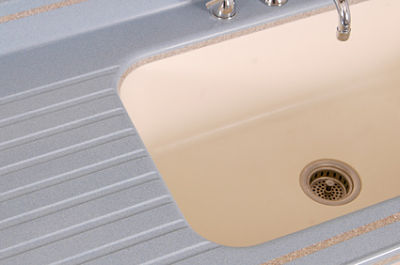Corian Sink
When it comes to solid surface sinks most people think of a Corian sink from DuPont. Most people call solid surface material Corain because they were the first to come out with this technology, in 1969. This is incorrect though, other solid surface manufacturers include Avonite, Fountainhead, Wilsonart, Gibraltar, and Surell.
Corian sinks are an acrylic polymer mixed with thermosetting plastics. Thermoforming is accomplished by heating the material to over 300°F and forming it around a mold. Corain sinks also have the advantages of a wide range of textures. This is accomplished by using different grit sandpapers in the finishing process.

Corian sinks come in a very wide range of colors, shapes, and sizes. The other manufacturers have a wide selection as well.
Joining the pieces together, requires the use acrylic resin and a belt sander to get the seams to disappear. Great care and skill is needed to get the pieces to come together as tight as possible. An experienced solid surface fabricator can make a seamless transition that's invisible.
The use of a solid surface sinks requires the use of a solid surface countertop from the same manufacturer if a seamless design is desired. You can also purchase self rimming sinks in solid surface as well and due to its wide range of colors it can match or complement any countertop or decor.
The disadvantages of solid surface sinks are they are susceptible to melting from high heat. Once the sinks are glued to the countertop they are there forever. An experienced solid surface fabricator can change the sink, but that involves removing the countertop and cutting out the sink. This can only be accomplished by an experienced fabricator. The new sink has to be the same size or larger but also needs to fit in the existing cabinet space.
The advantages of a Corian sink, and the other manufacturers, is the wide range of colors, shapes, and sizes. The seamless design is more hygienic because there are no crevices for food, grime, and moisture to build up. Scratches and chips can easily be fixed with a little sandpaper. Most people aren't comfortable with sanding their sinks because they are afraid of damaging the surface. What I recommend is to get a lesson from the fabricator on how to fix the scratches This can save you money down the road. As well as give you the confidence to do it yourself.
Costs range from $200 to $1,000 based on the complexity of the design. Extreme designs require the fabricator to take extra time to meld the two pieces together and create a seamless transition.
The durability is outstanding if high heat items don't touch the surface. If a mistake happens it can easily be sanded away. Light colors tend to darken in the scratches and a dark color will show scratches as being lighter in color.
Cleanliness is outstanding due to the seamless design. No little places for grime to collect and abrasive cleaners have little effect on these sinks.
Sound is not an issue with these sinks as there are generally quite thick.
Depths range from 6" to 12" and also come in one, two, and three bowl designs. Sizes can also vary in the same sink giving you more uses in the same space.
In summary solid surface sinks have all the advantages of other sinks with the ability to fix chips and scratches. Get a chip in a cast iron sink and you have to get a new one but not with solid surface. The advantages far outweigh the disadvantages when it comes to this sink material. It can last a lifetime if properly cared for.




